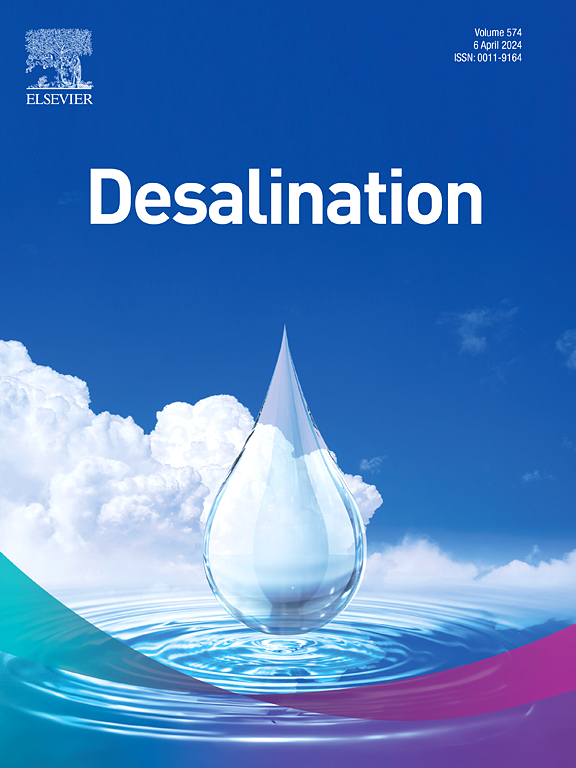Enhancing the antifouling properties and permeability of polyamide TFC RO membranes via Ag3PO4 nanoparticle incorporation
IF 9.8
1区 工程技术
Q1 ENGINEERING, CHEMICAL
引用次数: 0
Abstract
Freshwater scarcity remains a critical global challenge, driving the advancement of efficient and sustainable desalination technologies like reverse osmosis (RO). Here, thin-film composite (TFC) RO membranes were modified by embedding silver orthophosphate (Ag3PO4) nanoparticles into the polyamide active layer to enhance antifouling performance, water permeability, and resistance to chlorine-induced degradation. Ag3PO4, known for its strong antibacterial activity, was incorporated via interfacial polymerization. The resulting membranes were systematically characterized in terms of surface morphology, hydrophilicity, surface charge, and chemical functionality. The optimal membrane containing 0.01 g Ag3PO4 exhibited a reduced contact angle of 48.8° (by 20 %), confirming enhanced surface hydrophilicity, and a slightly more negative zeta potential compared to the bare membrane. It achieved a water flux of 66 L/m2.h at an operating pressure of 1.5 MPa, high salt rejection (98.4 %), and excellent antifouling behavior, with a flux recovery ratio of 94 % after protein fouling and physical cleaning. Chlorine resistance was significantly enhanced, with only ∼1 % decline in salt rejection after chlorination, compared to >10 % loss in the unmodified membrane. Long-term operational stability under saline conditions was confirmed, with ∼99 % salt rejection maintained over 96 h. These results demonstrate the potential of Ag3PO4 as an effective additive for developing robust, high-performance TFC RO membranes for practical water purification applications.

Ag3PO4纳米颗粒掺入提高聚酰胺TFC反渗透膜的防污性能和渗透性
淡水短缺仍然是一个严峻的全球挑战,推动了反渗透(RO)等高效和可持续的海水淡化技术的发展。本研究通过在聚酰胺活性层中嵌入正磷酸银(Ag3PO4)纳米颗粒来修饰薄膜复合(TFC)反渗透膜,以提高其防污性能、透水性和抗氯诱导降解能力。Ag3PO4具有较强的抗菌活性,通过界面聚合加入。所得到的膜在表面形态、亲水性、表面电荷和化学功能方面进行了系统的表征。含有0.01 g Ag3PO4的最佳膜的接触角降低了48.8°(20%),证实了表面亲水性增强,并且与裸膜相比,zeta电位略高。在1.5 MPa操作压力下,水通量为66 L/m2.h,除盐率高(98.4%),具有优异的防污性能,经过蛋白质污染和物理清洗后的通量回收率为94%。抗氯性显著增强,氯化后的盐截留率仅下降~ 1%,而未经改性的膜的盐截留率下降了10%。在盐水条件下的长期运行稳定性得到了证实,在96小时内保持了~ 99%的盐去除率。这些结果表明,Ag3PO4作为一种有效的添加剂,有潜力开发出坚固、高性能的TFC反渗透膜,用于实际的水净化应用。
本文章由计算机程序翻译,如有差异,请以英文原文为准。
求助全文
约1分钟内获得全文
求助全文
来源期刊

Desalination
工程技术-工程:化工
CiteScore
14.60
自引率
20.20%
发文量
619
审稿时长
41 days
期刊介绍:
Desalination is a scholarly journal that focuses on the field of desalination materials, processes, and associated technologies. It encompasses a wide range of disciplines and aims to publish exceptional papers in this area.
The journal invites submissions that explicitly revolve around water desalting and its applications to various sources such as seawater, groundwater, and wastewater. It particularly encourages research on diverse desalination methods including thermal, membrane, sorption, and hybrid processes.
By providing a platform for innovative studies, Desalination aims to advance the understanding and development of desalination technologies, promoting sustainable solutions for water scarcity challenges.
 求助内容:
求助内容: 应助结果提醒方式:
应助结果提醒方式:


